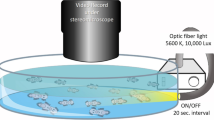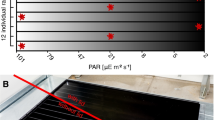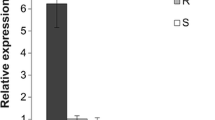Abstract
Chemotaxis is widespread across many taxa and often aids resource acquisition or predator avoidance. Species interactions can modify the degree of movement facilitated by chemotaxis. In this study, we investigated the influence of symbionts on Paramecium bursaria’s chemotactic behavior toward chloroviruses. To achieve this, we performed choice experiments using chlorovirus and control candidate attractors (virus stabilization buffer and pond water). We quantified the movement of Paramecia grown with or without algal and viral symbionts toward each attractor. All Paramecia showed some chemotaxis toward viruses, but cells without algae and viruses showed the most movement toward viruses. Thus, the endosymbiotic algae (zoochlorellae) appeared to alter the movement of Paramecia toward chloroviruses, but it was not clear that ectosymbiotic viruses (chlorovirus) also had this effect. The change in behavior was consistent with a change in swimming speed, but a change in attraction remains possible. The potential costs and benefits of chemotactic movement toward chloroviruses for either the Paramecia hosts or its symbionts remain unclear.


Similar content being viewed by others
Data Availability
The datasets used in the current study are available from the corresponding author upon reasonable request.
References
Brown JA, Nielsen PJ (1974) Transfer of photosynthetically produced carbohydrate from endosymbiotic chlorellae to Paramecium bursaria. J Protozool 21(4):569–570. https://doi.org/10.1111/j.1550-7408.1974.tb03702.x
Bulannga RB, Schmidt S (2023) Two predators, one prey—the interaction between bacteriophage, bacterivorous ciliates, and Escherichia coli. Microb Ecol. https://doi.org/10.1007/s00248-022-02163-w
DeLong JP, Al-Ameeli Z, Duncan G, Van Etten JL, Dunigan DD (2016) Predators catalyze an increase in chloroviruses by foraging on the symbiotic hosts of zoochlorellae. Proc Natl Acad Sci 113(48):13780–13784. https://doi.org/10.1073/pnas.1613843113
DeLong JP, Van Etten JL, Al-Ameeli Z, Agarkova IV, Dunigan DD (2023) The consumption of viruses returns energy to food chains. Proc Natl Acad Sci 120(1):e2215000120. https://doi.org/10.1073/pnas.2215000120
DeLong JP, Van Etten JL, Dunigan DD (2023) Lessons from chloroviruses: the complex and diverse roles of viruses in food webs. J Virol 0(0), e00275-23https://doi.org/10.1128/jvi.00275-23
Dunigan DD, Al-Sammak M, Al-Ameeli Z, Agarkova IV, DeLong JP, Van Etten JL (2019) Chloroviruses lure hosts through long-distance chemical signaling. J Virol 93(7):e01688-e1718. https://doi.org/10.1128/JVI.01688-18
Engl T, Kaltenpoth M (2018) Influence of microbial symbionts on insect pheromones. Nat Prod Rep 35(5):386–397. https://doi.org/10.1039/C7NP00068E
Hansson L (1997) Behavioural response in plants: adjustment in algal recruitment induced by herbivores. Proc R Soc London, Ser B 263(1374):1241–1244. https://doi.org/10.1098/rspb.1996.0182
Kandasamy D, Gershenzon J, Andersson MN, Hammerbacher A (2019) Volatile organic compounds influence the interaction of the Eurasian spruce bark beetle (Ips typographus) with its fungal symbionts. ISME J 13(7):1788–1800. https://doi.org/10.1038/s41396-019-0390-3. Article 7
Karakashian SJ (1963) Growth of Paramecium bursaria as influenced by the presence of algal symbionts. Physiol Zool 36(1):52–68. https://doi.org/10.1086/physzool.36.1.30152738
Kavaliers M, Wiebe JP, Galea LAM (1994) Reduction of predator odor-induced anxiety in mice by the neurosteroid 3α-hydroxy-4-pregnen-20-one (3αHP). Brain Res 645(1):325–329. https://doi.org/10.1016/0006-8993(94)91667-5
Mathis A, Chivers DP, Smith RJF (1993) Population differences in responses of fathead minnows (Pimephales promelas) to visual and chemical stimuli from predators. Ethology 93(1):31–40. https://doi.org/10.1111/j.1439-0310.1993.tb00976.x
O’halloran DM, Burnell AM (2003) An investigation of chemotaxis in the insect parasitic nematode Heterorhabditis bacteriophora. Parasitology 127(4):375–385. https://doi.org/10.1017/S0031182003003688
Olive M, Moerman F, Fernandez-Cassi X, Altermatt F, Kohn T (2022) Removal of waterborne viruses by Tetrahymena pyriformis is virus-specific and coincides with changes in protist swimming speed. Environ Sci Technol 56(7):4062–4070. https://doi.org/10.1021/acs.est.1c05518
Petri B, Sanz M-J (2018) Neutrophil chemotaxis. Cell Tissue Res 371(3):425–436. https://doi.org/10.1007/s00441-017-2776-8
Raina J-B, Fernandez V, Lambert B, Stocker R, Seymour JR (2019) The role of microbial motility and chemotaxis in symbiosis. Nat Rev Microbiol 17(5):284–294. https://doi.org/10.1038/s41579-019-0182-9. Article 5
Reeder PB, Ache BW (1980) Chemotaxis in the Florida spiny lobster, Panulirus argus. Animal Behav 28(3):831–839. https://doi.org/10.1016/S0003-3472(80)80143-6
Richard F-J, Poulsen M, Hefetz A, Errard C, Nash DR, Boomsma JJ (2007) The origin of the chemical profiles of fungal symbionts and their significance for nestmate recognition in Acromyrmex leaf-cutting ants. Behav Ecol Sociobiol 61(11):1637–1649. https://doi.org/10.1007/s00265-007-0395-1
Salsbery ME (2022) Evolutionary and ecological consequences of symbiosis in Paramecium bursaria [Ph.D., The University of Nebraska - Lincoln]. https://www.proquest.com/docview/2658283323/abstract/612CA1EEEE944738PQ/1
Salsbery ME, DeLong JP (2018) The benefit of algae endosymbionts in Paramecium bursaria is temperature dependent. Evol Ecol Res 19(6):669–678
Salsbery ME, DeLong JP (2021) Thermal adaptation in a holobiont accompanied by phenotypic changes in an endosymbiont. Evolution 75(8):2074–2084. https://doi.org/10.1111/evo.14301
Shu L, Zhang B, Queller DC, Strassmann JE (2018) Burkholderia bacteria use chemotaxis to find social amoeba Dictyostelium discoideum hosts. ISME J 12(8):977–1993. https://doi.org/10.1038/s41396-018-0147-4. Article 8
Stone CF, Moore J (2014) Parasite-induced alteration of odour responses in an amphipod–acanthocephalan system. Int J Parasitol 44(13):969–975. https://doi.org/10.1016/j.ijpara.2014.06.012
Van Etten JL, Burbank DE, Kuczmarski D, Meints RH (1983) Virus infection of culturable chlorella-like algae and development of a plaque assay. Science 219(4587):994–996
Van Etten JL, Lane LC, Meints RH (1991) Viruses and virus-like particles of eukaryotic algae. Microbiol Rev 55(4):586–620. https://doi.org/10.1128/mr.55.4.586-620.1991
Wong-Ng J, Celani A, Vergassola M (2018) Exploring the function of bacterial chemotaxis. Curr Opin Microbiol 45:16–21. https://doi.org/10.1016/j.mib.2018.01.010
Yashchenko VV, Gavrilova OV, Rautian MS, Jakobsen KS (2012) Association of Paramecium bursaria chlorella viruses with Paramecium bursaria cells: ultrastructural studies. Eur J Protistol 48(2):149–159. https://doi.org/10.1016/j.ejop.2011.05.002
Funding
This work was partially supported by the National Science Foundation under grant 1736030 (to JLVE, DDD, and JPD), the University of Nebraska—Lincoln Agricultural Research Division and the Office of Research and Economic Development (to DDD), the University of Nebraska Foundation Algal Virus Research Funds (JVE), and a University of Nebraska Layman Award (to JPD, DDD, and JLVE).
Author information
Authors and Affiliations
Contributions
Huy Ho, Miranda Salsbery, David Dunigan, James Van Etten, and John DeLong contributed to the study conception and design. Material preparation, data collection and analysis were performed by Huy Ho, Miranda Salsbery, Irina Agarkova, Zeina Al-Ameeli, David Dunigan, and John DeLong. The first draft of the manuscript was written by Huy Ho and John DeLong, and David Dunigan, James Van Etten, and Miranda Salsbery contributed to subsequent versions of the manuscript. All authors read and approved the final manuscript.
Corresponding author
Ethics declarations
Competing Interests
The authors declare no competing interests.
Rights and permissions
Springer Nature or its licensor (e.g. a society or other partner) holds exclusive rights to this article under a publishing agreement with the author(s) or other rightsholder(s); author self-archiving of the accepted manuscript version of this article is solely governed by the terms of such publishing agreement and applicable law.
About this article
Cite this article
Ho, H.V.N., Dunigan, D.D., Salsbery, M.E. et al. Viral Chemotaxis of Paramecium Bursaria Altered by Algal Endosymbionts. Microb Ecol 86, 2904–2909 (2023). https://doi.org/10.1007/s00248-023-02292-w
Received:
Accepted:
Published:
Issue Date:
DOI: https://doi.org/10.1007/s00248-023-02292-w




